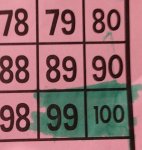One of the best things about working with first graders is that they have internalized very few procedures and algorithms. So when they are posed with a problem or scenario, they are eager to develop their own problem solving method and most of the time, they are enthusiastic to share their thinking. In contrast, high school students, when presented with an unfamiliar problem, often try to scroll l back through their mental library of mathematical procedures and then attempt to apply one that seems to fit the scenario.
Because of spring break and other conflicts, it has been about a month since I’ve worked with the first graders so I decided to bring something a little different. Rather than pose an open ended problem with multiple solution paths (but ultimately one correct answer), I brought something more exploratory. And I started with the 100s chart.

The hundreds chart: a capstone to the foundation of a solid elementary math program. One of the first tools students use when working with bigger numbers. And there is so much beauty and structure to it that kids can see when working with it slightly under its surface.
Thanks to this week’s featured primary level problems on Nrich, I decided to let the children explore some relationships with numbers on the hundreds chart. I had them choose any two “next-door” numbers and then add them together. (Surprising to me was that at least one person in each group chose 99 and 100).
First graders have not had much exposure with adding two two-digit numbers, but based on my experience with these kids, I knew they could give it a go. For the most part, we were able to break the sums down into friendly numbers. This was exciting stuff to see them work through.
Now the fun part: I listed all of their sums and asked them what they noticed. And when you give kids a set of 4 things, and they are familiar with the Which One Doesn’t Belong routine, they can’t help but tell you which one doesn’t belong. In summary, we were convinced, based on the variety of examples we had, that when we added the “next-door” numbers, the result would be odd.
Another amazing characteristic of first graders is that once you explore one avenue of a problem, their minds open up to an infinite number of other possibilities for exploration.
- What do you think will happen if we add numbers that are on top of each other?
- What will we get if we add diagonal numbers?
- What about if we add three numbers in a row instead of just two?
And the music to any educator’s ears at the end of a lesson: Can I take this home so I can figure more stuff out?





